Analysis of Sustainable Tourism Development and Planning in Qatar
VerifiedAdded on 2024/06/07
|38
|5991
|348
Report
AI Summary
This report provides a comprehensive analysis of sustainable tourism development in Qatar, examining the rationale for planning in the tourism industry, different approaches to tourism planning and development at international, national, and regional levels, and the significance of interactive planning systems. It justifies the introduction of sustainability in tourism development, analyzes factors hindering sustainable tourism, and evaluates methods for resolving conflicts of interest. The report also compares tourism development issues in developing countries and emerging destinations, evaluates the moral and ethical issues of enclave tourism in Qatar, and offers recommendations for the future development of tourism, emphasizing the importance of public-private partnerships and sustainable practices. Desklib provides access to similar solved assignments and study resources for students.
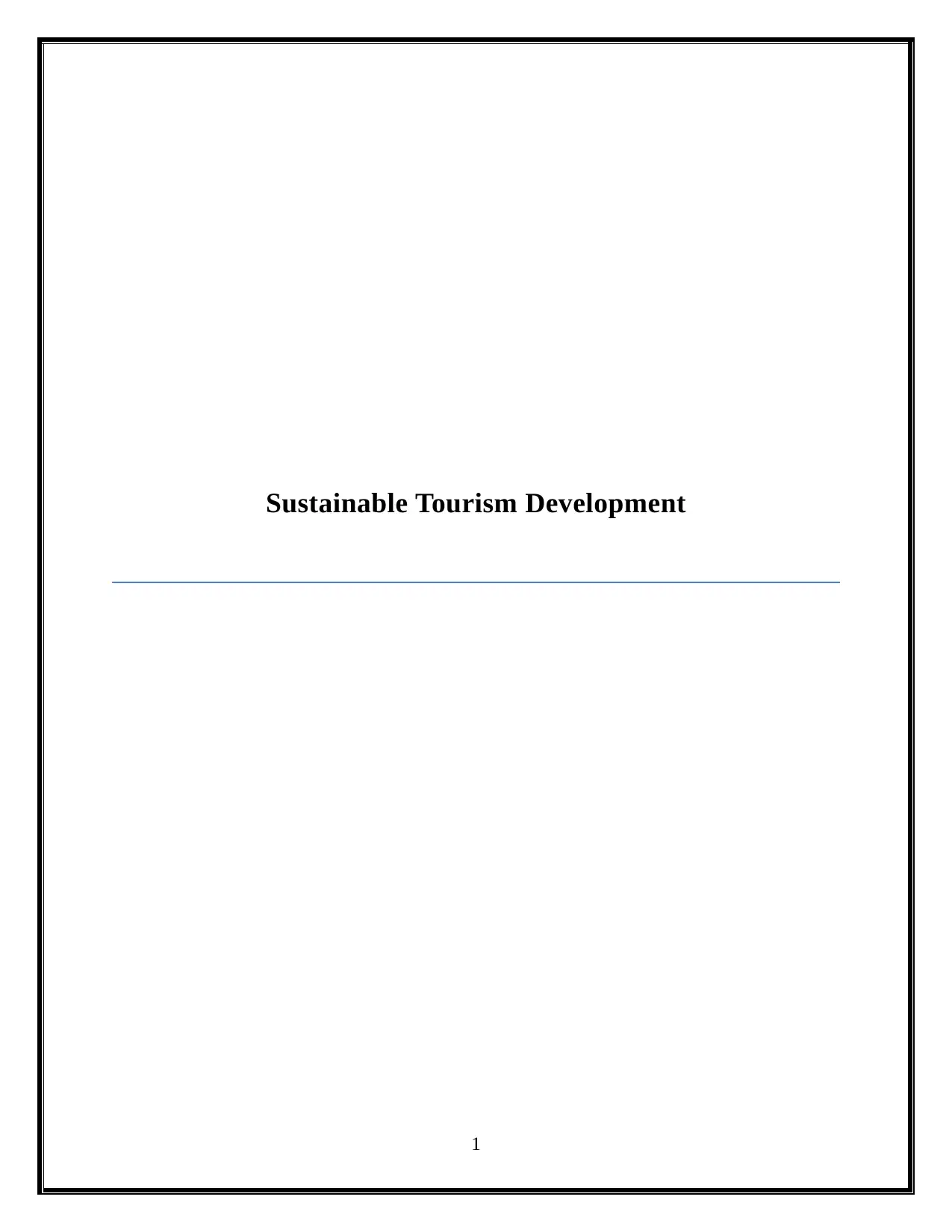
Sustainable Tourism Development
1
1
Paraphrase This Document
Need a fresh take? Get an instant paraphrase of this document with our AI Paraphraser
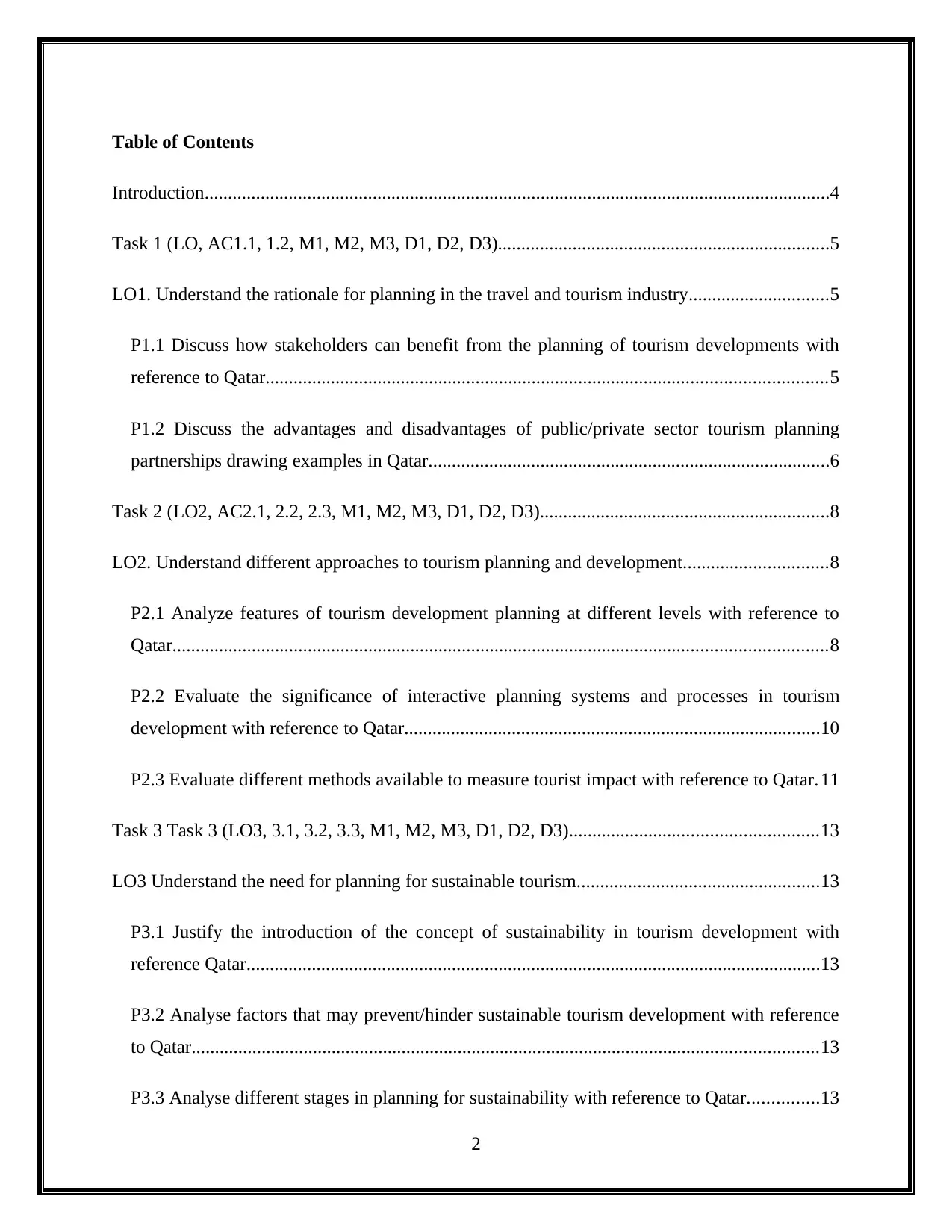
Table of Contents
Introduction......................................................................................................................................4
Task 1 (LO, AC1.1, 1.2, M1, M2, M3, D1, D2, D3).......................................................................5
LO1. Understand the rationale for planning in the travel and tourism industry..............................5
P1.1 Discuss how stakeholders can benefit from the planning of tourism developments with
reference to Qatar........................................................................................................................5
P1.2 Discuss the advantages and disadvantages of public/private sector tourism planning
partnerships drawing examples in Qatar......................................................................................6
Task 2 (LO2, AC2.1, 2.2, 2.3, M1, M2, M3, D1, D2, D3)..............................................................8
LO2. Understand different approaches to tourism planning and development...............................8
P2.1 Analyze features of tourism development planning at different levels with reference to
Qatar............................................................................................................................................8
P2.2 Evaluate the significance of interactive planning systems and processes in tourism
development with reference to Qatar.........................................................................................10
P2.3 Evaluate different methods available to measure tourist impact with reference to Qatar. 11
Task 3 Task 3 (LO3, 3.1, 3.2, 3.3, M1, M2, M3, D1, D2, D3).....................................................13
LO3 Understand the need for planning for sustainable tourism....................................................13
P3.1 Justify the introduction of the concept of sustainability in tourism development with
reference Qatar...........................................................................................................................13
P3.2 Analyse factors that may prevent/hinder sustainable tourism development with reference
to Qatar......................................................................................................................................13
P3.3 Analyse different stages in planning for sustainability with reference to Qatar...............13
2
Introduction......................................................................................................................................4
Task 1 (LO, AC1.1, 1.2, M1, M2, M3, D1, D2, D3).......................................................................5
LO1. Understand the rationale for planning in the travel and tourism industry..............................5
P1.1 Discuss how stakeholders can benefit from the planning of tourism developments with
reference to Qatar........................................................................................................................5
P1.2 Discuss the advantages and disadvantages of public/private sector tourism planning
partnerships drawing examples in Qatar......................................................................................6
Task 2 (LO2, AC2.1, 2.2, 2.3, M1, M2, M3, D1, D2, D3)..............................................................8
LO2. Understand different approaches to tourism planning and development...............................8
P2.1 Analyze features of tourism development planning at different levels with reference to
Qatar............................................................................................................................................8
P2.2 Evaluate the significance of interactive planning systems and processes in tourism
development with reference to Qatar.........................................................................................10
P2.3 Evaluate different methods available to measure tourist impact with reference to Qatar. 11
Task 3 Task 3 (LO3, 3.1, 3.2, 3.3, M1, M2, M3, D1, D2, D3).....................................................13
LO3 Understand the need for planning for sustainable tourism....................................................13
P3.1 Justify the introduction of the concept of sustainability in tourism development with
reference Qatar...........................................................................................................................13
P3.2 Analyse factors that may prevent/hinder sustainable tourism development with reference
to Qatar......................................................................................................................................13
P3.3 Analyse different stages in planning for sustainability with reference to Qatar...............13
2
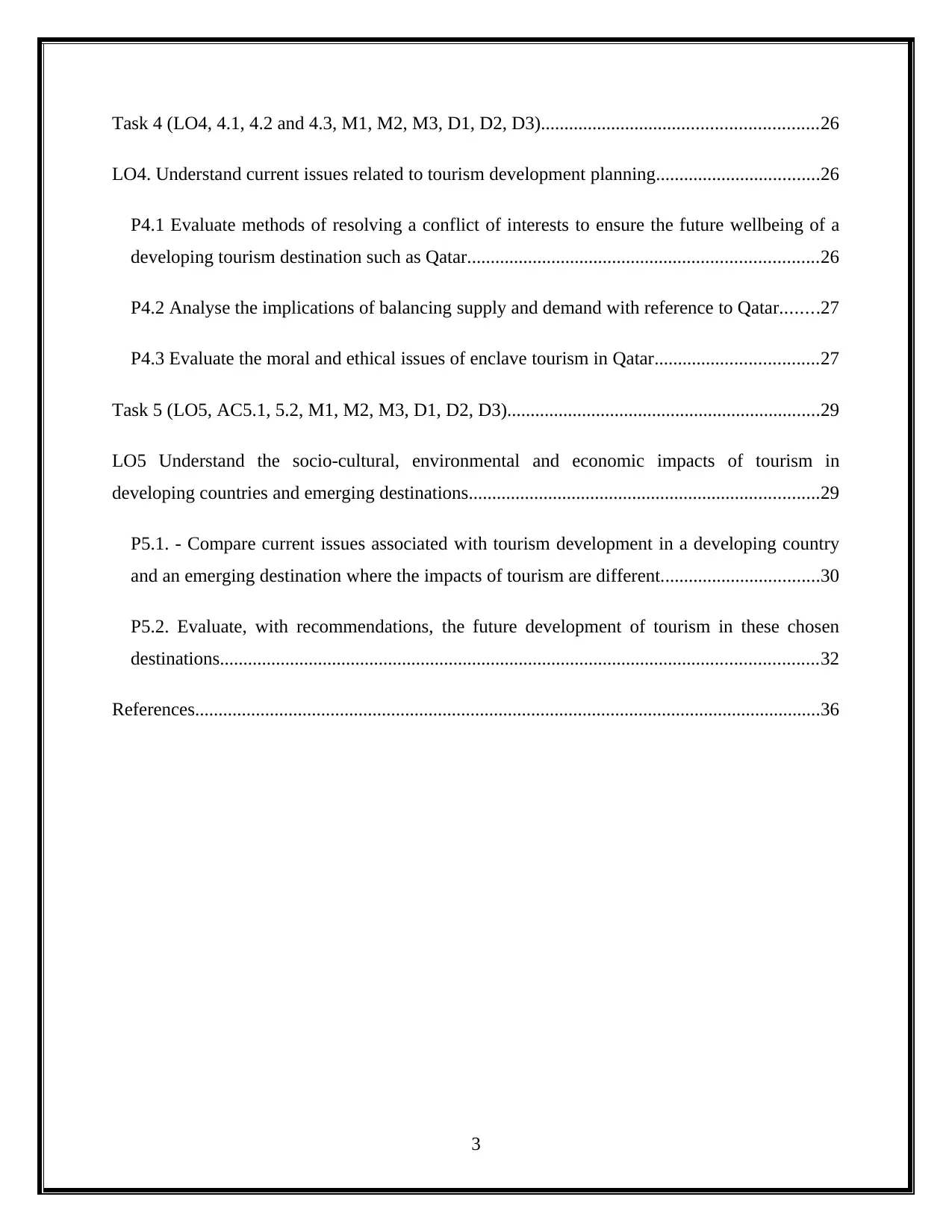
Task 4 (LO4, 4.1, 4.2 and 4.3, M1, M2, M3, D1, D2, D3)...........................................................26
LO4. Understand current issues related to tourism development planning...................................26
P4.1 Evaluate methods of resolving a conflict of interests to ensure the future wellbeing of a
developing tourism destination such as Qatar...........................................................................26
P4.2 Analyse the implications of balancing supply and demand with reference to Qatar........27
P4.3 Evaluate the moral and ethical issues of enclave tourism in Qatar...................................27
Task 5 (LO5, AC5.1, 5.2, M1, M2, M3, D1, D2, D3)...................................................................29
LO5 Understand the socio-cultural, environmental and economic impacts of tourism in
developing countries and emerging destinations...........................................................................29
P5.1. - Compare current issues associated with tourism development in a developing country
and an emerging destination where the impacts of tourism are different..................................30
P5.2. Evaluate, with recommendations, the future development of tourism in these chosen
destinations................................................................................................................................32
References......................................................................................................................................36
3
LO4. Understand current issues related to tourism development planning...................................26
P4.1 Evaluate methods of resolving a conflict of interests to ensure the future wellbeing of a
developing tourism destination such as Qatar...........................................................................26
P4.2 Analyse the implications of balancing supply and demand with reference to Qatar........27
P4.3 Evaluate the moral and ethical issues of enclave tourism in Qatar...................................27
Task 5 (LO5, AC5.1, 5.2, M1, M2, M3, D1, D2, D3)...................................................................29
LO5 Understand the socio-cultural, environmental and economic impacts of tourism in
developing countries and emerging destinations...........................................................................29
P5.1. - Compare current issues associated with tourism development in a developing country
and an emerging destination where the impacts of tourism are different..................................30
P5.2. Evaluate, with recommendations, the future development of tourism in these chosen
destinations................................................................................................................................32
References......................................................................................................................................36
3
⊘ This is a preview!⊘
Do you want full access?
Subscribe today to unlock all pages.

Trusted by 1+ million students worldwide
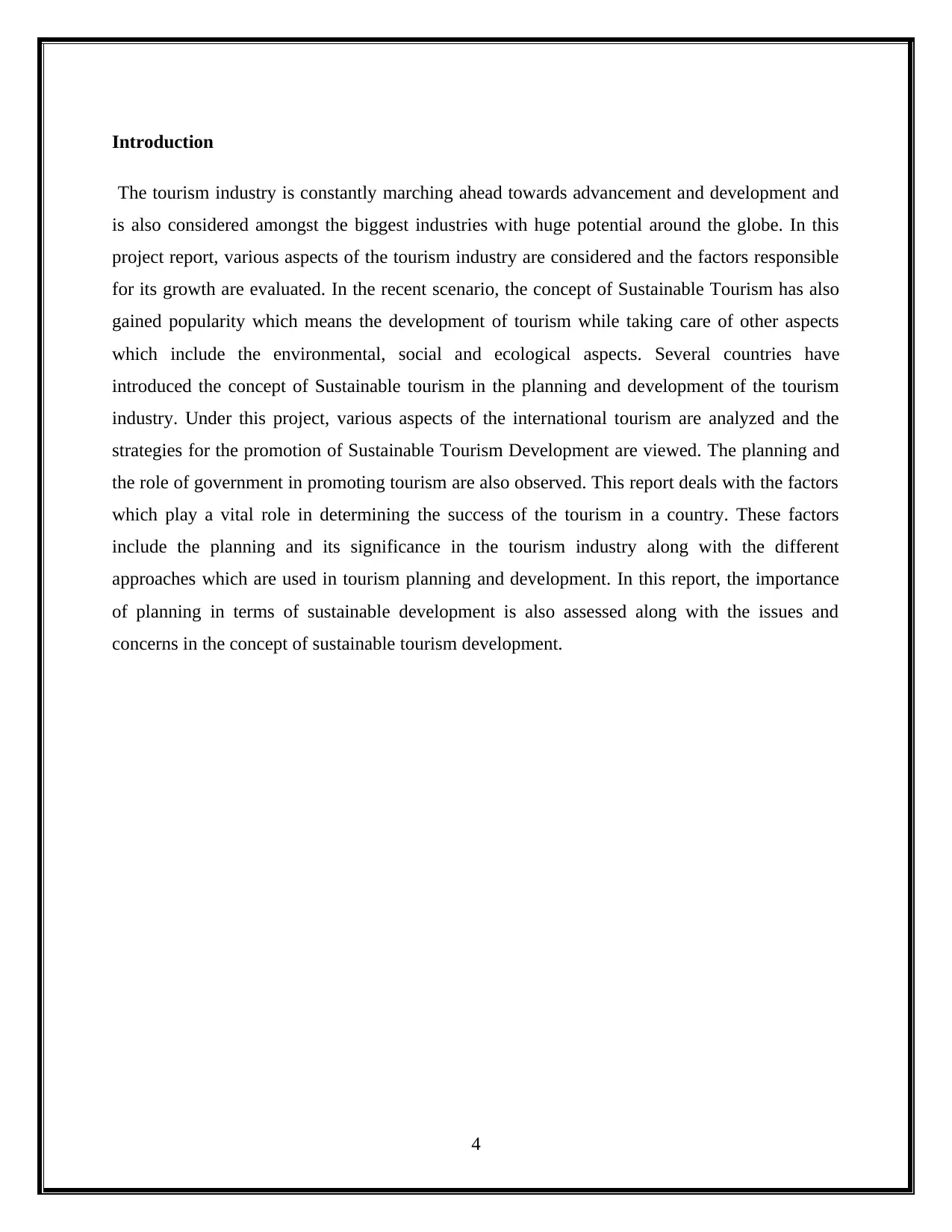
Introduction
The tourism industry is constantly marching ahead towards advancement and development and
is also considered amongst the biggest industries with huge potential around the globe. In this
project report, various aspects of the tourism industry are considered and the factors responsible
for its growth are evaluated. In the recent scenario, the concept of Sustainable Tourism has also
gained popularity which means the development of tourism while taking care of other aspects
which include the environmental, social and ecological aspects. Several countries have
introduced the concept of Sustainable tourism in the planning and development of the tourism
industry. Under this project, various aspects of the international tourism are analyzed and the
strategies for the promotion of Sustainable Tourism Development are viewed. The planning and
the role of government in promoting tourism are also observed. This report deals with the factors
which play a vital role in determining the success of the tourism in a country. These factors
include the planning and its significance in the tourism industry along with the different
approaches which are used in tourism planning and development. In this report, the importance
of planning in terms of sustainable development is also assessed along with the issues and
concerns in the concept of sustainable tourism development.
4
The tourism industry is constantly marching ahead towards advancement and development and
is also considered amongst the biggest industries with huge potential around the globe. In this
project report, various aspects of the tourism industry are considered and the factors responsible
for its growth are evaluated. In the recent scenario, the concept of Sustainable Tourism has also
gained popularity which means the development of tourism while taking care of other aspects
which include the environmental, social and ecological aspects. Several countries have
introduced the concept of Sustainable tourism in the planning and development of the tourism
industry. Under this project, various aspects of the international tourism are analyzed and the
strategies for the promotion of Sustainable Tourism Development are viewed. The planning and
the role of government in promoting tourism are also observed. This report deals with the factors
which play a vital role in determining the success of the tourism in a country. These factors
include the planning and its significance in the tourism industry along with the different
approaches which are used in tourism planning and development. In this report, the importance
of planning in terms of sustainable development is also assessed along with the issues and
concerns in the concept of sustainable tourism development.
4
Paraphrase This Document
Need a fresh take? Get an instant paraphrase of this document with our AI Paraphraser
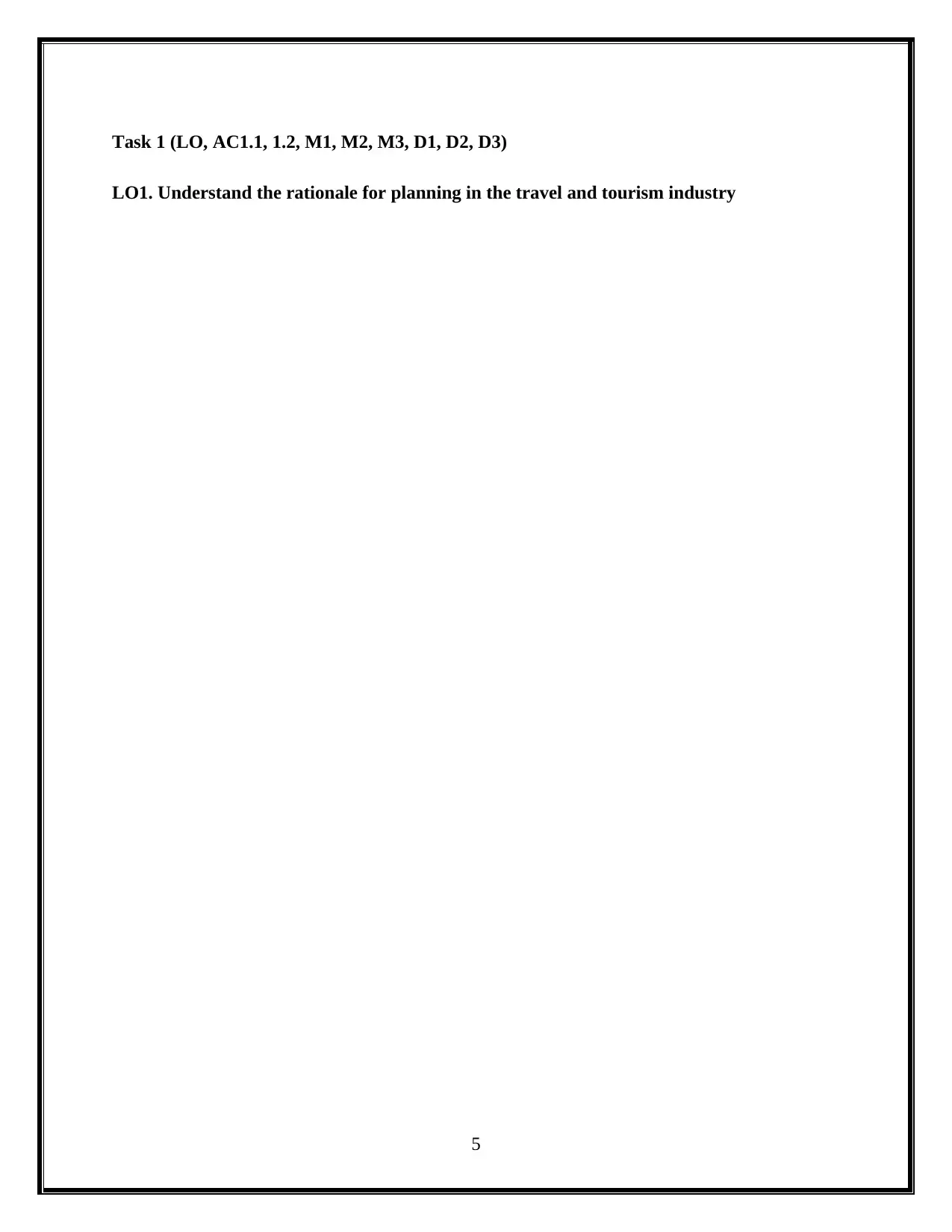
Task 1 (LO, AC1.1, 1.2, M1, M2, M3, D1, D2, D3)
LO1. Understand the rationale for planning in the travel and tourism industry
5
LO1. Understand the rationale for planning in the travel and tourism industry
5
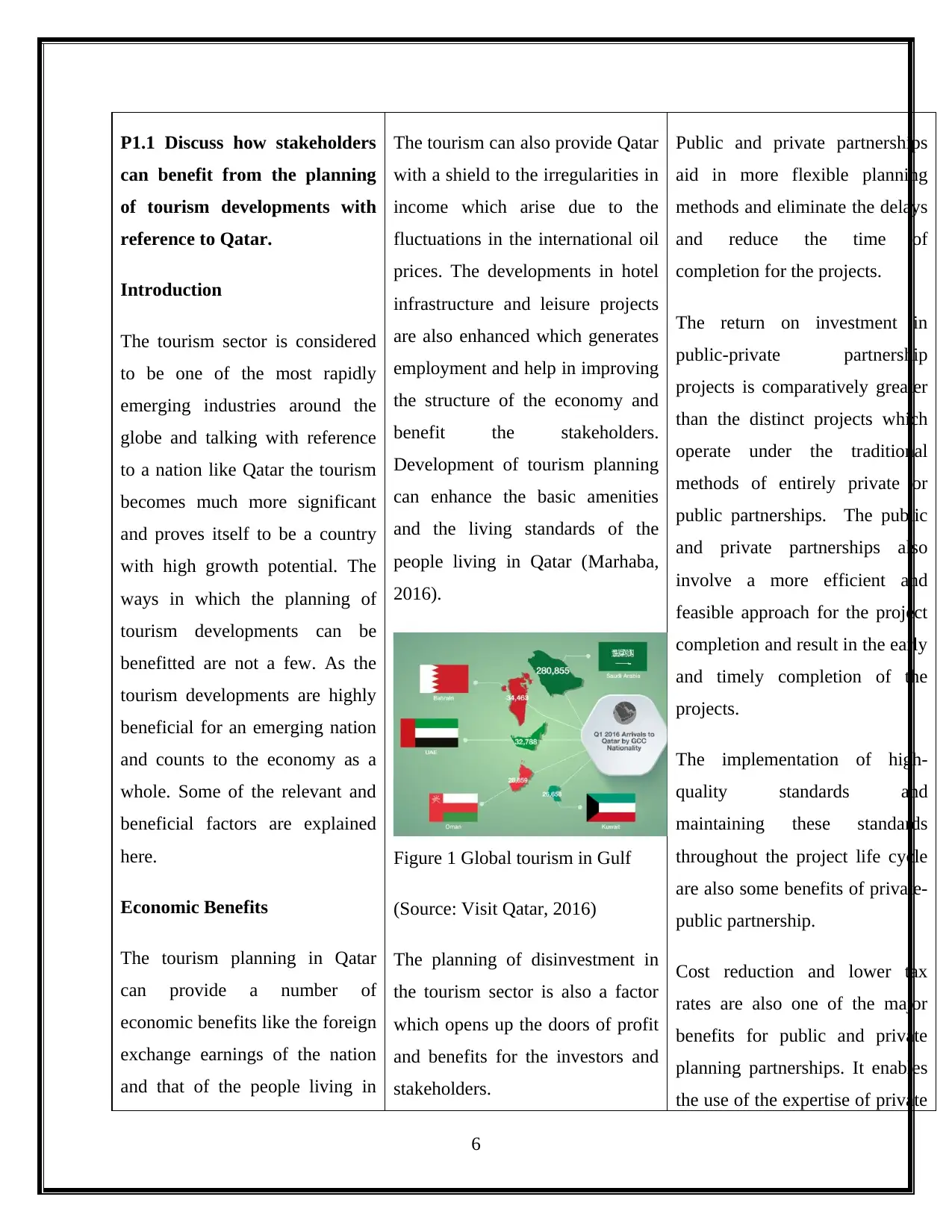
P1.1 Discuss how stakeholders
can benefit from the planning
of tourism developments with
reference to Qatar.
Introduction
The tourism sector is considered
to be one of the most rapidly
emerging industries around the
globe and talking with reference
to a nation like Qatar the tourism
becomes much more significant
and proves itself to be a country
with high growth potential. The
ways in which the planning of
tourism developments can be
benefitted are not a few. As the
tourism developments are highly
beneficial for an emerging nation
and counts to the economy as a
whole. Some of the relevant and
beneficial factors are explained
here.
Economic Benefits
The tourism planning in Qatar
can provide a number of
economic benefits like the foreign
exchange earnings of the nation
and that of the people living in
The tourism can also provide Qatar
with a shield to the irregularities in
income which arise due to the
fluctuations in the international oil
prices. The developments in hotel
infrastructure and leisure projects
are also enhanced which generates
employment and help in improving
the structure of the economy and
benefit the stakeholders.
Development of tourism planning
can enhance the basic amenities
and the living standards of the
people living in Qatar (Marhaba,
2016).
Figure 1 Global tourism in Gulf
(Source: Visit Qatar, 2016)
The planning of disinvestment in
the tourism sector is also a factor
which opens up the doors of profit
and benefits for the investors and
stakeholders.
Public and private partnerships
aid in more flexible planning
methods and eliminate the delays
and reduce the time of
completion for the projects.
The return on investment in
public-private partnership
projects is comparatively greater
than the distinct projects which
operate under the traditional
methods of entirely private or
public partnerships. The public
and private partnerships also
involve a more efficient and
feasible approach for the project
completion and result in the early
and timely completion of the
projects.
The implementation of high-
quality standards and
maintaining these standards
throughout the project life cycle
are also some benefits of private-
public partnership.
Cost reduction and lower tax
rates are also one of the major
benefits for public and private
planning partnerships. It enables
the use of the expertise of private
6
can benefit from the planning
of tourism developments with
reference to Qatar.
Introduction
The tourism sector is considered
to be one of the most rapidly
emerging industries around the
globe and talking with reference
to a nation like Qatar the tourism
becomes much more significant
and proves itself to be a country
with high growth potential. The
ways in which the planning of
tourism developments can be
benefitted are not a few. As the
tourism developments are highly
beneficial for an emerging nation
and counts to the economy as a
whole. Some of the relevant and
beneficial factors are explained
here.
Economic Benefits
The tourism planning in Qatar
can provide a number of
economic benefits like the foreign
exchange earnings of the nation
and that of the people living in
The tourism can also provide Qatar
with a shield to the irregularities in
income which arise due to the
fluctuations in the international oil
prices. The developments in hotel
infrastructure and leisure projects
are also enhanced which generates
employment and help in improving
the structure of the economy and
benefit the stakeholders.
Development of tourism planning
can enhance the basic amenities
and the living standards of the
people living in Qatar (Marhaba,
2016).
Figure 1 Global tourism in Gulf
(Source: Visit Qatar, 2016)
The planning of disinvestment in
the tourism sector is also a factor
which opens up the doors of profit
and benefits for the investors and
stakeholders.
Public and private partnerships
aid in more flexible planning
methods and eliminate the delays
and reduce the time of
completion for the projects.
The return on investment in
public-private partnership
projects is comparatively greater
than the distinct projects which
operate under the traditional
methods of entirely private or
public partnerships. The public
and private partnerships also
involve a more efficient and
feasible approach for the project
completion and result in the early
and timely completion of the
projects.
The implementation of high-
quality standards and
maintaining these standards
throughout the project life cycle
are also some benefits of private-
public partnership.
Cost reduction and lower tax
rates are also one of the major
benefits for public and private
planning partnerships. It enables
the use of the expertise of private
6
⊘ This is a preview!⊘
Do you want full access?
Subscribe today to unlock all pages.

Trusted by 1+ million students worldwide
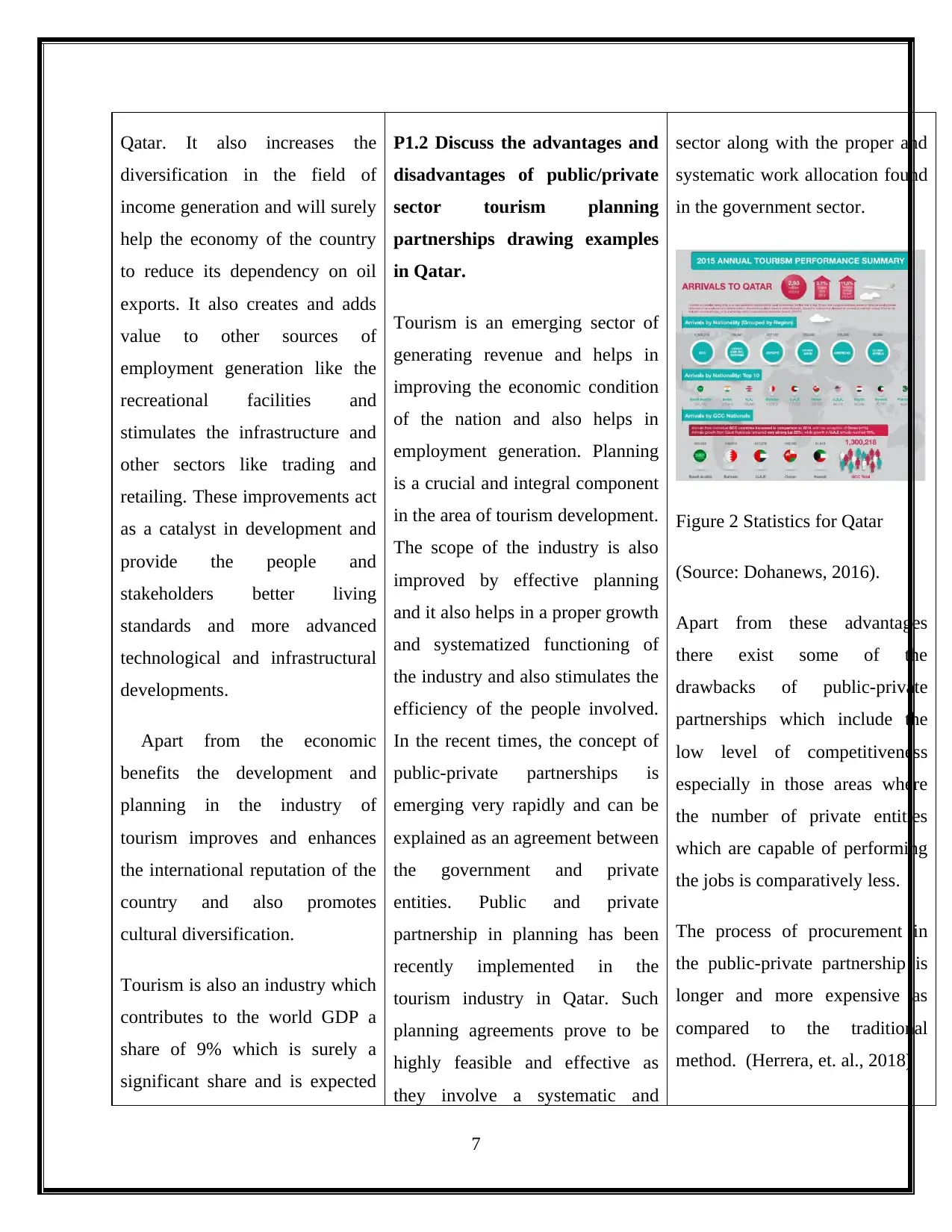
Qatar. It also increases the
diversification in the field of
income generation and will surely
help the economy of the country
to reduce its dependency on oil
exports. It also creates and adds
value to other sources of
employment generation like the
recreational facilities and
stimulates the infrastructure and
other sectors like trading and
retailing. These improvements act
as a catalyst in development and
provide the people and
stakeholders better living
standards and more advanced
technological and infrastructural
developments.
Apart from the economic
benefits the development and
planning in the industry of
tourism improves and enhances
the international reputation of the
country and also promotes
cultural diversification.
Tourism is also an industry which
contributes to the world GDP a
share of 9% which is surely a
significant share and is expected
P1.2 Discuss the advantages and
disadvantages of public/private
sector tourism planning
partnerships drawing examples
in Qatar.
Tourism is an emerging sector of
generating revenue and helps in
improving the economic condition
of the nation and also helps in
employment generation. Planning
is a crucial and integral component
in the area of tourism development.
The scope of the industry is also
improved by effective planning
and it also helps in a proper growth
and systematized functioning of
the industry and also stimulates the
efficiency of the people involved.
In the recent times, the concept of
public-private partnerships is
emerging very rapidly and can be
explained as an agreement between
the government and private
entities. Public and private
partnership in planning has been
recently implemented in the
tourism industry in Qatar. Such
planning agreements prove to be
highly feasible and effective as
they involve a systematic and
sector along with the proper and
systematic work allocation found
in the government sector.
Figure 2 Statistics for Qatar
(Source: Dohanews, 2016).
Apart from these advantages
there exist some of the
drawbacks of public-private
partnerships which include the
low level of competitiveness
especially in those areas where
the number of private entities
which are capable of performing
the jobs is comparatively less.
The process of procurement in
the public-private partnership is
longer and more expensive as
compared to the traditional
method. (Herrera, et. al., 2018)
7
diversification in the field of
income generation and will surely
help the economy of the country
to reduce its dependency on oil
exports. It also creates and adds
value to other sources of
employment generation like the
recreational facilities and
stimulates the infrastructure and
other sectors like trading and
retailing. These improvements act
as a catalyst in development and
provide the people and
stakeholders better living
standards and more advanced
technological and infrastructural
developments.
Apart from the economic
benefits the development and
planning in the industry of
tourism improves and enhances
the international reputation of the
country and also promotes
cultural diversification.
Tourism is also an industry which
contributes to the world GDP a
share of 9% which is surely a
significant share and is expected
P1.2 Discuss the advantages and
disadvantages of public/private
sector tourism planning
partnerships drawing examples
in Qatar.
Tourism is an emerging sector of
generating revenue and helps in
improving the economic condition
of the nation and also helps in
employment generation. Planning
is a crucial and integral component
in the area of tourism development.
The scope of the industry is also
improved by effective planning
and it also helps in a proper growth
and systematized functioning of
the industry and also stimulates the
efficiency of the people involved.
In the recent times, the concept of
public-private partnerships is
emerging very rapidly and can be
explained as an agreement between
the government and private
entities. Public and private
partnership in planning has been
recently implemented in the
tourism industry in Qatar. Such
planning agreements prove to be
highly feasible and effective as
they involve a systematic and
sector along with the proper and
systematic work allocation found
in the government sector.
Figure 2 Statistics for Qatar
(Source: Dohanews, 2016).
Apart from these advantages
there exist some of the
drawbacks of public-private
partnerships which include the
low level of competitiveness
especially in those areas where
the number of private entities
which are capable of performing
the jobs is comparatively less.
The process of procurement in
the public-private partnership is
longer and more expensive as
compared to the traditional
method. (Herrera, et. al., 2018)
7
Paraphrase This Document
Need a fresh take? Get an instant paraphrase of this document with our AI Paraphraser
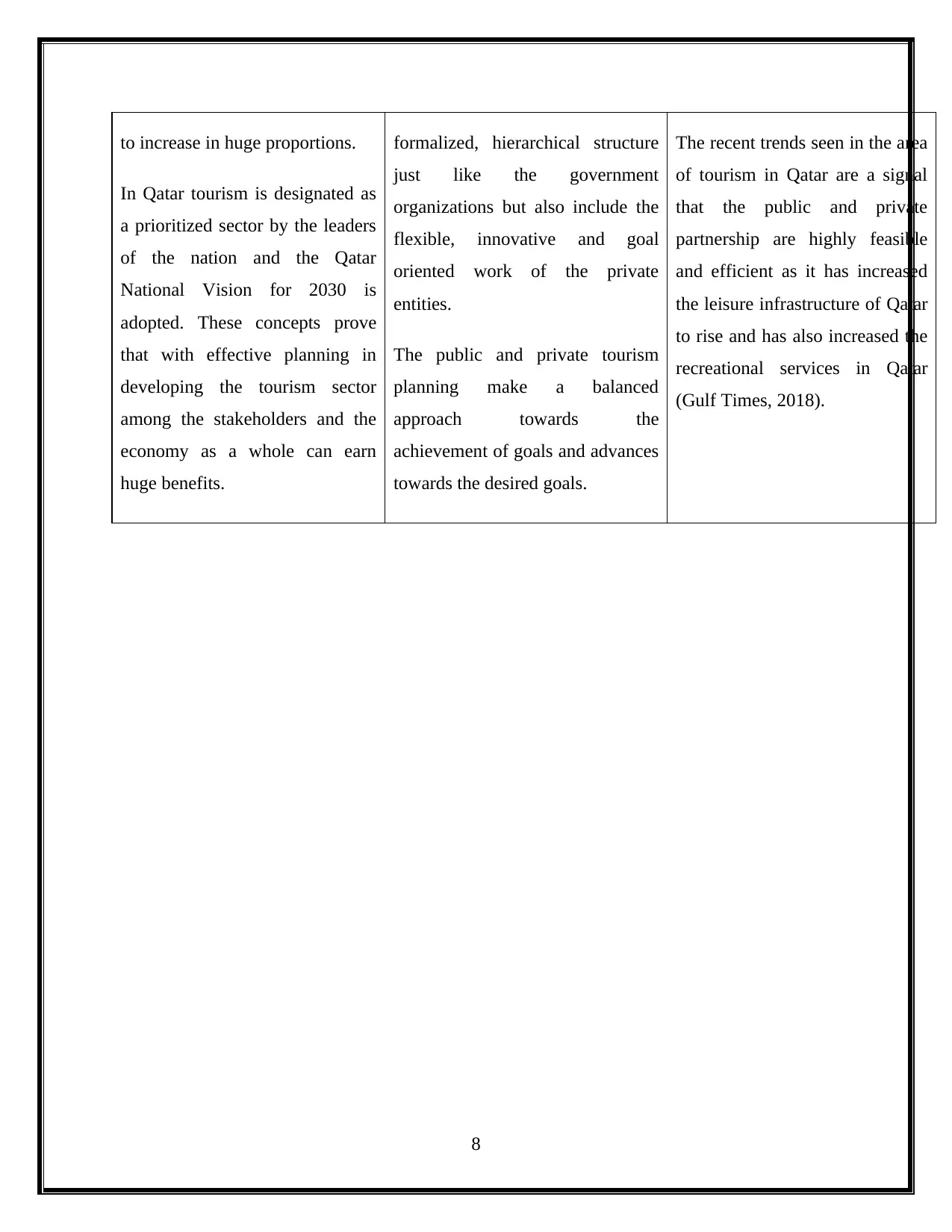
to increase in huge proportions.
In Qatar tourism is designated as
a prioritized sector by the leaders
of the nation and the Qatar
National Vision for 2030 is
adopted. These concepts prove
that with effective planning in
developing the tourism sector
among the stakeholders and the
economy as a whole can earn
huge benefits.
formalized, hierarchical structure
just like the government
organizations but also include the
flexible, innovative and goal
oriented work of the private
entities.
The public and private tourism
planning make a balanced
approach towards the
achievement of goals and advances
towards the desired goals.
The recent trends seen in the area
of tourism in Qatar are a signal
that the public and private
partnership are highly feasible
and efficient as it has increased
the leisure infrastructure of Qatar
to rise and has also increased the
recreational services in Qatar
(Gulf Times, 2018).
8
In Qatar tourism is designated as
a prioritized sector by the leaders
of the nation and the Qatar
National Vision for 2030 is
adopted. These concepts prove
that with effective planning in
developing the tourism sector
among the stakeholders and the
economy as a whole can earn
huge benefits.
formalized, hierarchical structure
just like the government
organizations but also include the
flexible, innovative and goal
oriented work of the private
entities.
The public and private tourism
planning make a balanced
approach towards the
achievement of goals and advances
towards the desired goals.
The recent trends seen in the area
of tourism in Qatar are a signal
that the public and private
partnership are highly feasible
and efficient as it has increased
the leisure infrastructure of Qatar
to rise and has also increased the
recreational services in Qatar
(Gulf Times, 2018).
8
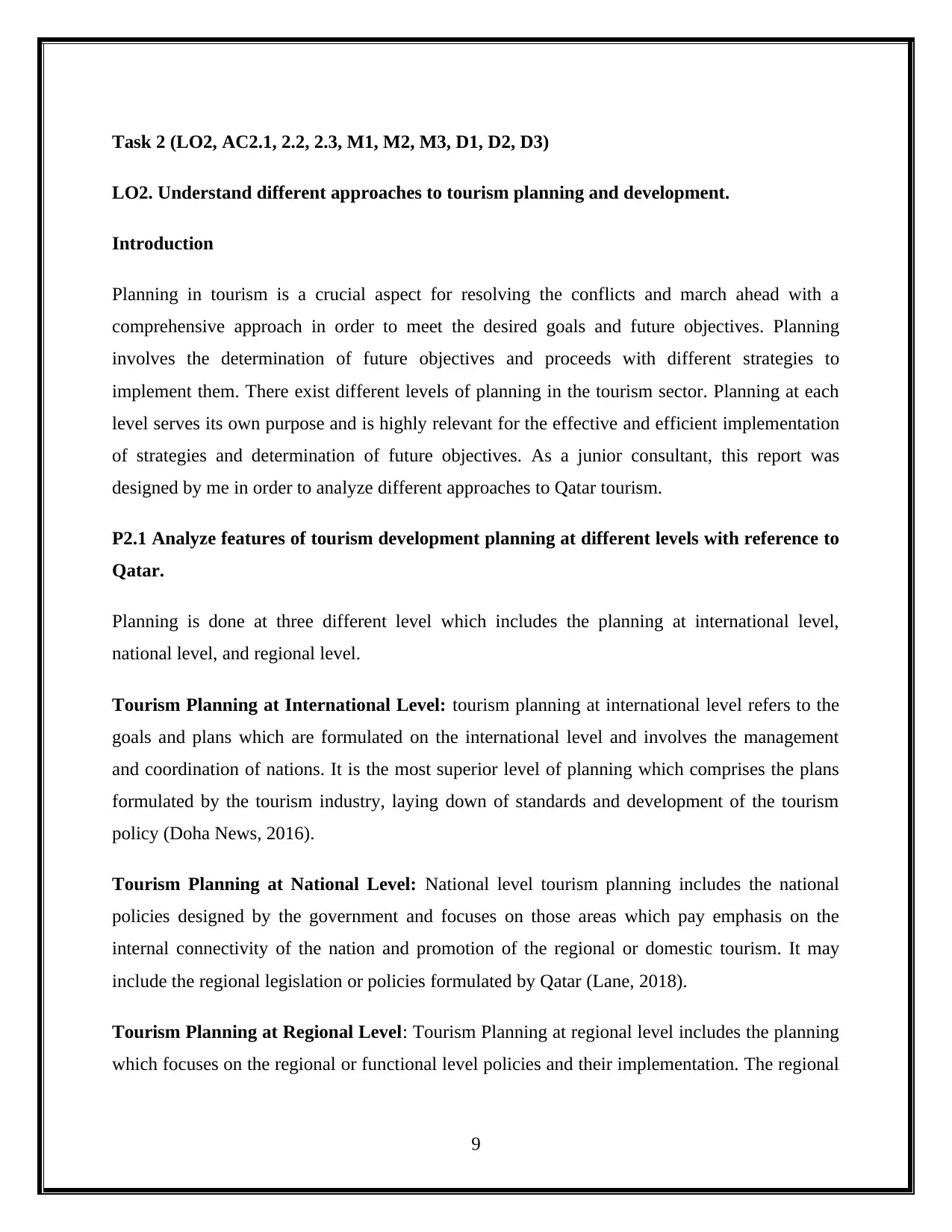
Task 2 (LO2, AC2.1, 2.2, 2.3, M1, M2, M3, D1, D2, D3)
LO2. Understand different approaches to tourism planning and development.
Introduction
Planning in tourism is a crucial aspect for resolving the conflicts and march ahead with a
comprehensive approach in order to meet the desired goals and future objectives. Planning
involves the determination of future objectives and proceeds with different strategies to
implement them. There exist different levels of planning in the tourism sector. Planning at each
level serves its own purpose and is highly relevant for the effective and efficient implementation
of strategies and determination of future objectives. As a junior consultant, this report was
designed by me in order to analyze different approaches to Qatar tourism.
P2.1 Analyze features of tourism development planning at different levels with reference to
Qatar.
Planning is done at three different level which includes the planning at international level,
national level, and regional level.
Tourism Planning at International Level: tourism planning at international level refers to the
goals and plans which are formulated on the international level and involves the management
and coordination of nations. It is the most superior level of planning which comprises the plans
formulated by the tourism industry, laying down of standards and development of the tourism
policy (Doha News, 2016).
Tourism Planning at National Level: National level tourism planning includes the national
policies designed by the government and focuses on those areas which pay emphasis on the
internal connectivity of the nation and promotion of the regional or domestic tourism. It may
include the regional legislation or policies formulated by Qatar (Lane, 2018).
Tourism Planning at Regional Level: Tourism Planning at regional level includes the planning
which focuses on the regional or functional level policies and their implementation. The regional
9
LO2. Understand different approaches to tourism planning and development.
Introduction
Planning in tourism is a crucial aspect for resolving the conflicts and march ahead with a
comprehensive approach in order to meet the desired goals and future objectives. Planning
involves the determination of future objectives and proceeds with different strategies to
implement them. There exist different levels of planning in the tourism sector. Planning at each
level serves its own purpose and is highly relevant for the effective and efficient implementation
of strategies and determination of future objectives. As a junior consultant, this report was
designed by me in order to analyze different approaches to Qatar tourism.
P2.1 Analyze features of tourism development planning at different levels with reference to
Qatar.
Planning is done at three different level which includes the planning at international level,
national level, and regional level.
Tourism Planning at International Level: tourism planning at international level refers to the
goals and plans which are formulated on the international level and involves the management
and coordination of nations. It is the most superior level of planning which comprises the plans
formulated by the tourism industry, laying down of standards and development of the tourism
policy (Doha News, 2016).
Tourism Planning at National Level: National level tourism planning includes the national
policies designed by the government and focuses on those areas which pay emphasis on the
internal connectivity of the nation and promotion of the regional or domestic tourism. It may
include the regional legislation or policies formulated by Qatar (Lane, 2018).
Tourism Planning at Regional Level: Tourism Planning at regional level includes the planning
which focuses on the regional or functional level policies and their implementation. The regional
9
⊘ This is a preview!⊘
Do you want full access?
Subscribe today to unlock all pages.

Trusted by 1+ million students worldwide
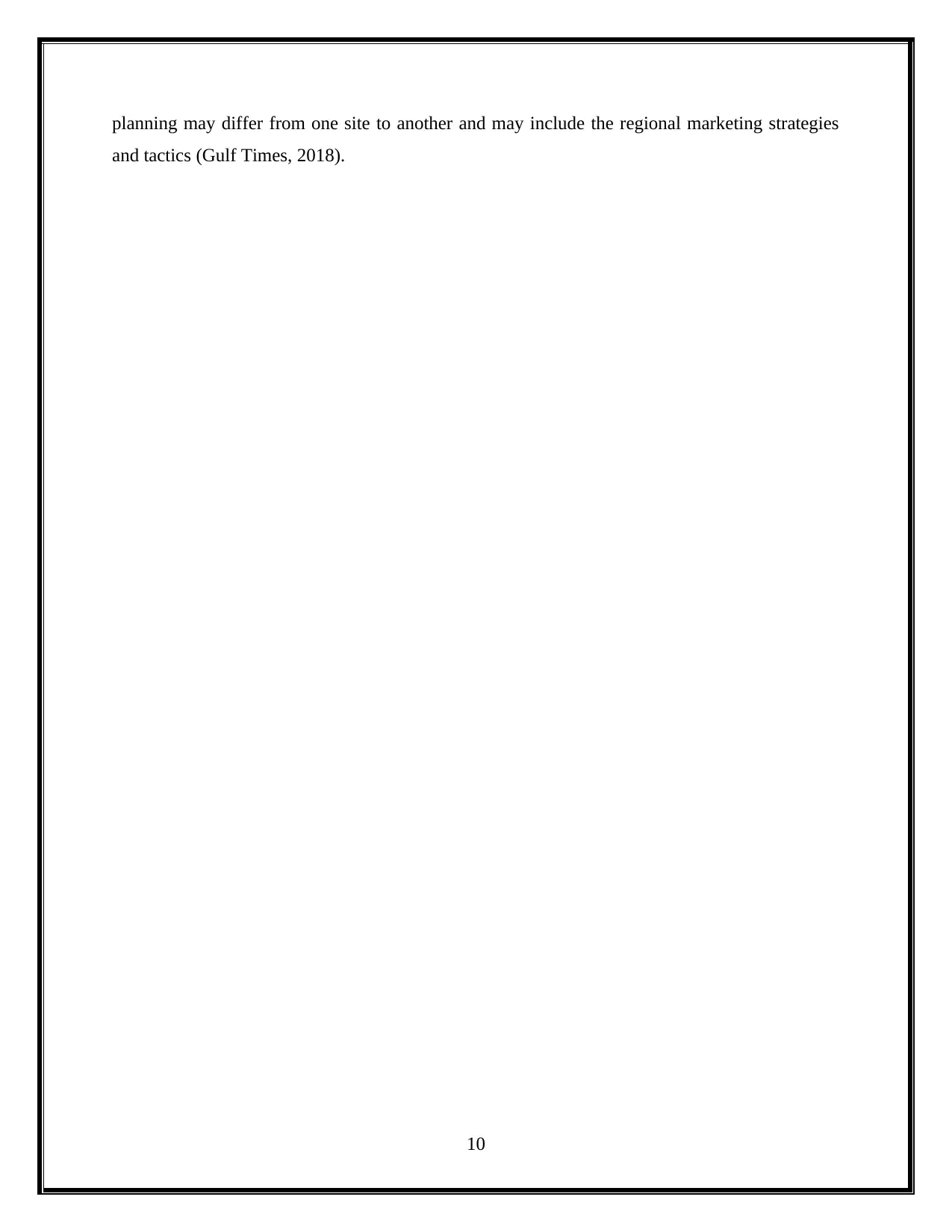
planning may differ from one site to another and may include the regional marketing strategies
and tactics (Gulf Times, 2018).
10
and tactics (Gulf Times, 2018).
10
Paraphrase This Document
Need a fresh take? Get an instant paraphrase of this document with our AI Paraphraser
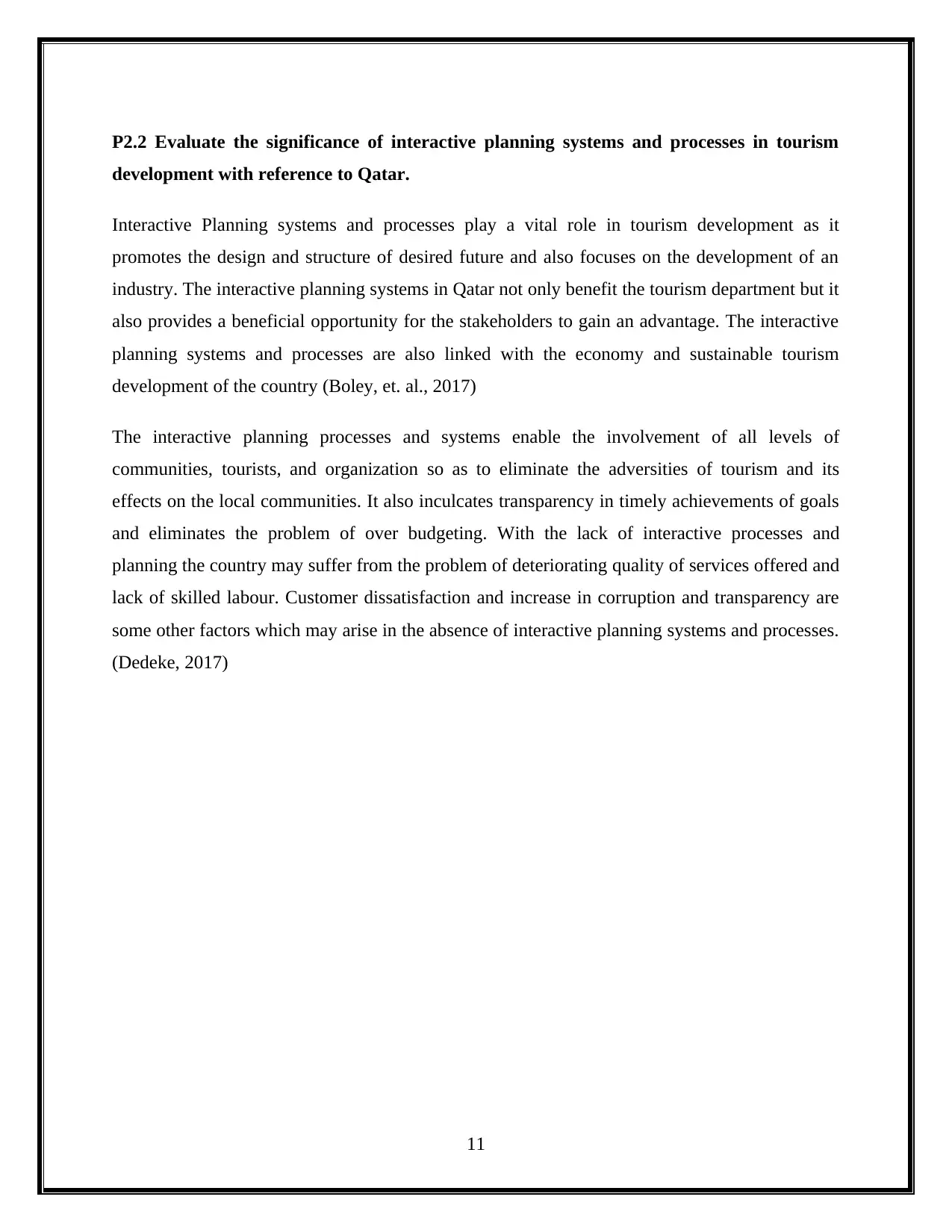
P2.2 Evaluate the significance of interactive planning systems and processes in tourism
development with reference to Qatar.
Interactive Planning systems and processes play a vital role in tourism development as it
promotes the design and structure of desired future and also focuses on the development of an
industry. The interactive planning systems in Qatar not only benefit the tourism department but it
also provides a beneficial opportunity for the stakeholders to gain an advantage. The interactive
planning systems and processes are also linked with the economy and sustainable tourism
development of the country (Boley, et. al., 2017)
The interactive planning processes and systems enable the involvement of all levels of
communities, tourists, and organization so as to eliminate the adversities of tourism and its
effects on the local communities. It also inculcates transparency in timely achievements of goals
and eliminates the problem of over budgeting. With the lack of interactive processes and
planning the country may suffer from the problem of deteriorating quality of services offered and
lack of skilled labour. Customer dissatisfaction and increase in corruption and transparency are
some other factors which may arise in the absence of interactive planning systems and processes.
(Dedeke, 2017)
11
development with reference to Qatar.
Interactive Planning systems and processes play a vital role in tourism development as it
promotes the design and structure of desired future and also focuses on the development of an
industry. The interactive planning systems in Qatar not only benefit the tourism department but it
also provides a beneficial opportunity for the stakeholders to gain an advantage. The interactive
planning systems and processes are also linked with the economy and sustainable tourism
development of the country (Boley, et. al., 2017)
The interactive planning processes and systems enable the involvement of all levels of
communities, tourists, and organization so as to eliminate the adversities of tourism and its
effects on the local communities. It also inculcates transparency in timely achievements of goals
and eliminates the problem of over budgeting. With the lack of interactive processes and
planning the country may suffer from the problem of deteriorating quality of services offered and
lack of skilled labour. Customer dissatisfaction and increase in corruption and transparency are
some other factors which may arise in the absence of interactive planning systems and processes.
(Dedeke, 2017)
11
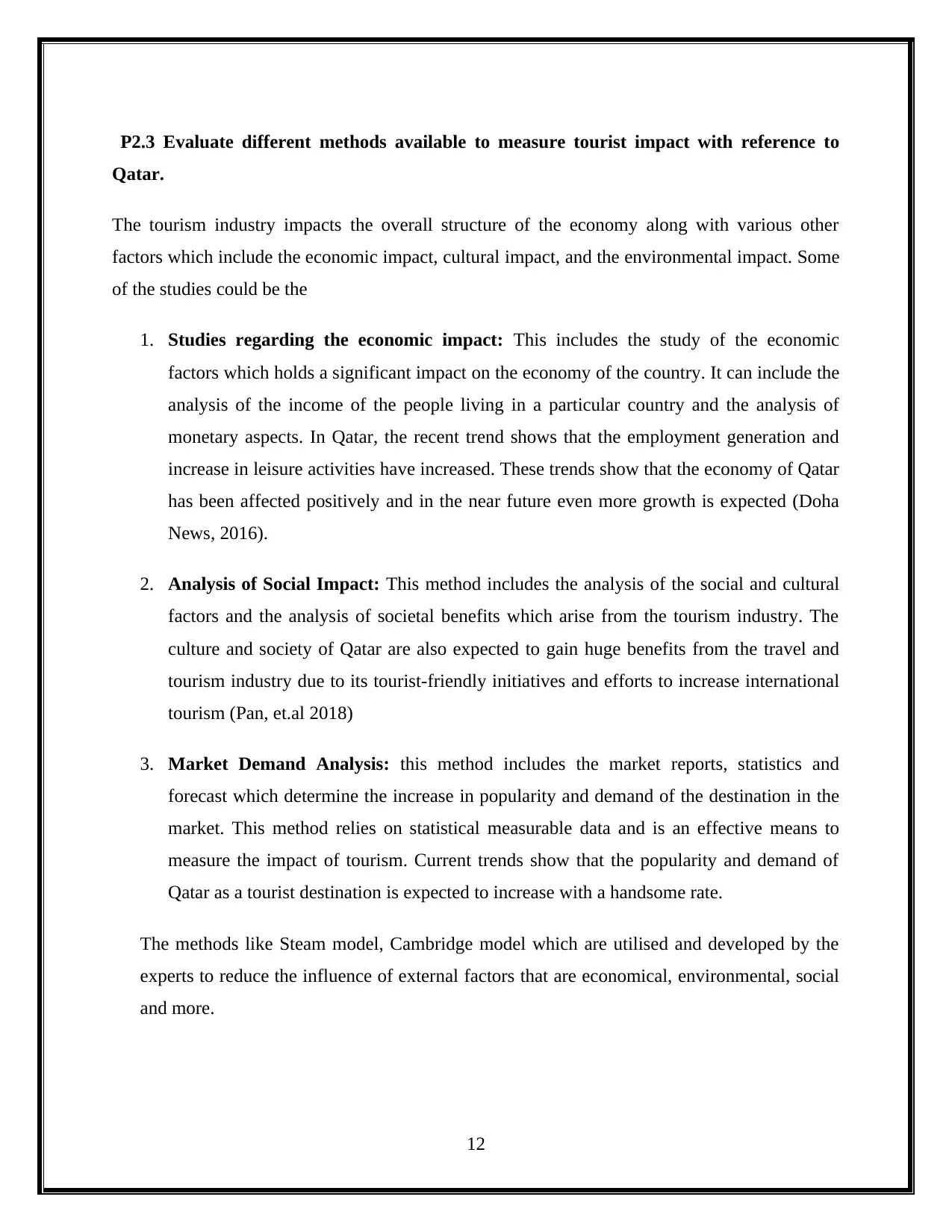
P2.3 Evaluate different methods available to measure tourist impact with reference to
Qatar.
The tourism industry impacts the overall structure of the economy along with various other
factors which include the economic impact, cultural impact, and the environmental impact. Some
of the studies could be the
1. Studies regarding the economic impact: This includes the study of the economic
factors which holds a significant impact on the economy of the country. It can include the
analysis of the income of the people living in a particular country and the analysis of
monetary aspects. In Qatar, the recent trend shows that the employment generation and
increase in leisure activities have increased. These trends show that the economy of Qatar
has been affected positively and in the near future even more growth is expected (Doha
News, 2016).
2. Analysis of Social Impact: This method includes the analysis of the social and cultural
factors and the analysis of societal benefits which arise from the tourism industry. The
culture and society of Qatar are also expected to gain huge benefits from the travel and
tourism industry due to its tourist-friendly initiatives and efforts to increase international
tourism (Pan, et.al 2018)
3. Market Demand Analysis: this method includes the market reports, statistics and
forecast which determine the increase in popularity and demand of the destination in the
market. This method relies on statistical measurable data and is an effective means to
measure the impact of tourism. Current trends show that the popularity and demand of
Qatar as a tourist destination is expected to increase with a handsome rate.
The methods like Steam model, Cambridge model which are utilised and developed by the
experts to reduce the influence of external factors that are economical, environmental, social
and more.
12
Qatar.
The tourism industry impacts the overall structure of the economy along with various other
factors which include the economic impact, cultural impact, and the environmental impact. Some
of the studies could be the
1. Studies regarding the economic impact: This includes the study of the economic
factors which holds a significant impact on the economy of the country. It can include the
analysis of the income of the people living in a particular country and the analysis of
monetary aspects. In Qatar, the recent trend shows that the employment generation and
increase in leisure activities have increased. These trends show that the economy of Qatar
has been affected positively and in the near future even more growth is expected (Doha
News, 2016).
2. Analysis of Social Impact: This method includes the analysis of the social and cultural
factors and the analysis of societal benefits which arise from the tourism industry. The
culture and society of Qatar are also expected to gain huge benefits from the travel and
tourism industry due to its tourist-friendly initiatives and efforts to increase international
tourism (Pan, et.al 2018)
3. Market Demand Analysis: this method includes the market reports, statistics and
forecast which determine the increase in popularity and demand of the destination in the
market. This method relies on statistical measurable data and is an effective means to
measure the impact of tourism. Current trends show that the popularity and demand of
Qatar as a tourist destination is expected to increase with a handsome rate.
The methods like Steam model, Cambridge model which are utilised and developed by the
experts to reduce the influence of external factors that are economical, environmental, social
and more.
12
⊘ This is a preview!⊘
Do you want full access?
Subscribe today to unlock all pages.

Trusted by 1+ million students worldwide
1 out of 38
Related Documents
Your All-in-One AI-Powered Toolkit for Academic Success.
+13062052269
info@desklib.com
Available 24*7 on WhatsApp / Email
![[object Object]](/_next/static/media/star-bottom.7253800d.svg)
Unlock your academic potential
Copyright © 2020–2025 A2Z Services. All Rights Reserved. Developed and managed by ZUCOL.



